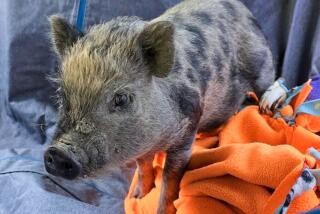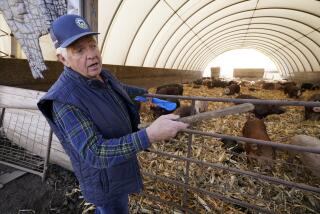Farm a Haven for Once-Chic Pigs : Pets: What do you do with a ‘pint-size’ porker that grows to 300 pounds, then starts biting the kids? Two men provide a home and hope for rejected animals.
- Share via
CHARLES TOWN, W. Va — Dale Riffle is dedicated to the once-chic, but now homeless. His beneficiaries wallow in the dirt, grunt rudely, and always act piggish.
Riffle has turned five acres of farmland into a sanctuary for Vietnamese potbellied pigs, the fad pets of the 1980s whose lives now often end at the dog pound or slaughterhouse.
“The majority of the general public thinks these pigs are going to weigh 30 to 40 pounds and can live in the house just like a cat or a dog,” Riffle said.
“They were lied to. The pig got bigger than what they were told it would get. The pig is much more work than they were told it would be. It’s more than they can handle.”
Since 1992, Riffle, 32, and partner Jim Brewer, 41, have provided a nonprofit home to “miniature” porkers as they work to find them futures that don’t include bacon.
“We found out that people were dumping them alongside the road or wherever they could to get rid of them,” Riffle said. “We thought, ‘Somebody’s got to do something. Why not us?’ ”
Riffle gave up a home near Annapolis, Md., and a career as head of a mail-order catalogue department for a Washington nonprofit agency. He runs the farm with the help of tax-free donations and some monthly stipends from former pig owners.
The native Asian pigs, less than one-fifth the size of a domestic pig, first entered the United States in 1988 for zoos and quickly became a novelty pet for the wealthy, selling for as much as $25,000.
“A litter of six could be worth $50,000,” said Susan Armstrong, president of the 250-member North American Potbellied Pig Assn. “It became a very lucrative business for a very short time.”
With excessive breeding, prices dropped to $400 by 1990 and pigs surfaced at flea markets and auctions, and in newspaper ads.
Billed as the new house pet, the pigs were promoted as intelligent, friendly animals that could live in apartments and condos with no fuss or, just as important, no muss.
But Riffle says size was relative and many of those “miniature” pigs grew to more than 200 pounds. Too many times, the pigs showed their nasty sides, turning on spouses, visitors and children, he said.
“I swallowed the bait on my first pig,” said Barbara Boughton, 39, of Winchester, Va. “He was supposed to be cute and weigh 40 pounds. Not true. This guy was somewhere near 300 pounds and mean as a snake. Anyone that came to visit had to put their running shoes on because he would go after everyone.”
He said more than half the 82 pigs at his sanctuary were left because they were what he calls “attack pigs.” Many involved owners who found their child’s arm or leg in the pig’s mouth.
Potbellied pig breeder Gerald Brown Jr. of Honeybrook, Pa., calls that kind of criticism hogwash.
“Eighty-five percent of the problem pigs this man is talking about can be straightened out,” Brown said.
“That’s poor training. That’s letting that pig rule you. They’ll outthink a human quicker than you would even know.
“There are some crazy pigs, but a majority of the pigs can be corrected by putting that pig in his place.”
Since the first 14 pigs were brought to the country through Canada in the late 1980s, the nation’s potbellied pig population now numbers more than 200,000, and an Indiana registry service, the largest of three, has papers on more than 21,000, Armstrong said.
Brown said people also are drawn to potbellies because they don’t bother allergy sufferers, have no odor-producing sweat glands, don’t get fleas and can be trained to use a litter box.
They are normally between 18 and 24 inches tall and can be 4 feet long. The pigs also have a swayed back and a potbelly, while a domestic pig has an arched back.
Unlike the curly tail of the domestic pig, potbellies have straight tails that, like dogs, wag when they are happy.
“You can teach a pig to do anything,” Brown said. “You can teach a dog something and a pig will do it better.”
Armstrong, who sees the pigs’ popularity continuing to spiral upward, says Riffle merely sees the worst cases. Riffle argues that it was just unfair to bring them into the country.
“In the United States, 12 million dogs and cats are killed every year because they can’t find homes for them,” Riffle said. “Why do we need another domestic pet? We can’t even take care of what we’ve got.”
Riffle’s pigs are kept in a dozen herds ranging in size from two to 14, living either in barns or sheds. Each area has a fenced run where the pigs can roam or take a dip in a plastic wading pool during warm weather.
But finding new homes for the pigs is a problem. Just 10 left the sanctuary last year despite tours and advertisements. “About half of the calls were people who wanted to eat them,” Riffle said.
More to Read
Sign up for Essential California
The most important California stories and recommendations in your inbox every morning.
You may occasionally receive promotional content from the Los Angeles Times.












